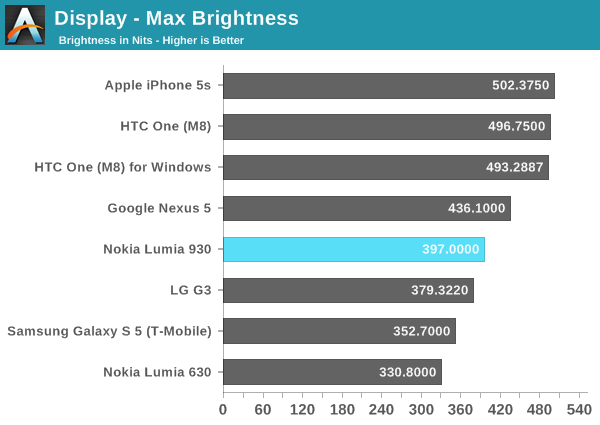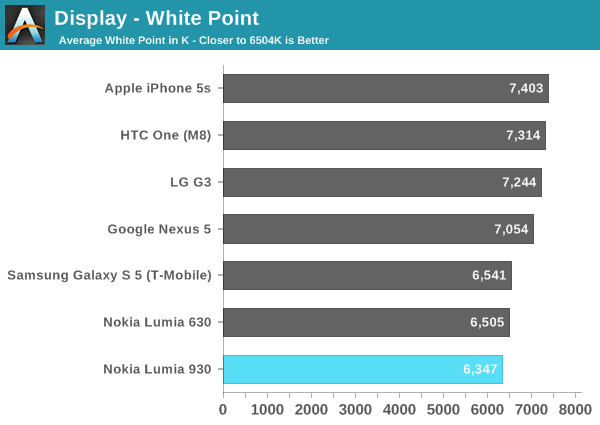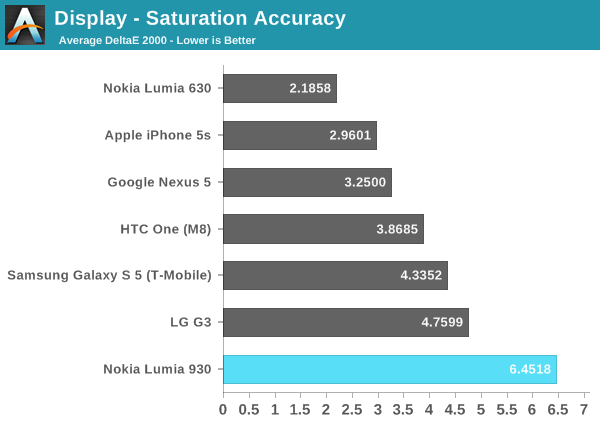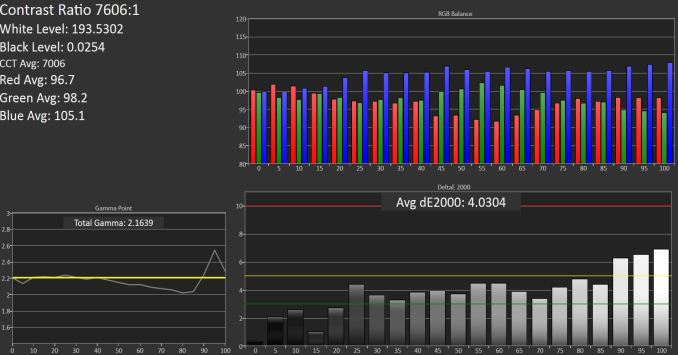Nokia Lumia 930 Review
by Brett Howse on September 8, 2014 3:00 PM EST- Posted in
- Smartphones
- Microsoft
- Nokia
- Mobile
- windows phone
- Lumia
Display
The Lumia 930 packs a 5” 1920x1080 resolution AMOLED display into its chassis. As seems to be the norm for higher resolution AMOLED, the Lumia 930 uses a RGBG Pentile matrix. AMOLED seems to have a lot more issues with color reproduction than most LCD displays, but the recent showing from Samsung with the Galaxy S5 and especially the Galaxy S5 LTE-A model have proven that an accurate AMOLED display can be done. The question is if it was done in this case. As display quality is one thing that can still differentiate one device from another, it is an important point. No part of a smartphone is used more than the display.
The latest Lumia devices with the Nokia “Cyan” firmware offer more customization of display settings than ever before, with fully adjustable brightness, and the ability to adjust color temperature, tint, and saturation. This is a huge step forward, but the hope is that the display can be accurate out of the box as well.
Like the Lumia 630 we recently looked at, the Lumia 930 also supports Nokia’s ClearBlack technology for better outdoor viewing and better black levels due to a reduction in reflections in the display layers. In addition, the device has Corning Gorilla Glass 3, a high brightness mode for outdoor viewing, and a second enhancement for outdoor viewing which Nokia calls “Sunlight readability enhancements” and is a method of performing content-adaptive backlight control (CABC) to adjust the perceived brightness of an image, but rather than doing full-frame CABC which is the common method of doing this, Nokia’s implementation utilizes Assertive Display technology from Apical. Rather than perform the CABC on an entire image, Assertive Display performs the adjustment on a per-pixel level. This can dramatically increase the usability of a display in bright sunlight and it does so without necessarily using more display power. Below is a sample of the Lumia 930 with the feature both on and off.
 Sunlight Readbility Off (upper picture) vs On (lower picture)
Sunlight Readbility Off (upper picture) vs On (lower picture)
This photo is somewhat of a worst case scenario, with a very dark image outside under the full sun. The bottom image is with the Sunlight Readability Mode enabled, and you can see that more of the image is visible.
To test the display accuracy, we turn to Spectralcal’s CalMAN 5 software package with a custom workflow. We utilize the X-Rite i1Pro Spectrophotometer for color accuracy and saturation, and the X-Rite i1Display Pro for contrast ratios. As this is an AMOLED display, we generally ignore the contrast ratios and black levels since the black level of AMOLED is zero, meaning the contrast ratio for all AMOLED displays is infinite.

The maximum brightness is very good for an AMOLED device at around 400 nits. Other 1080p AMOLED displays include the Galaxy S5, which only comes in at 350 nits. The maximum output was achieved in the outdoor viewing mode, with normal brightness levels kept much lower. It is a good result for this type of display and certainly helps with the phone being able to be used outdoors.


Now we can start to see some issues with the Nokia’s implementation of this AMOLED display. White Point is pretty good at 6347. What is missing though is green, which starts to drop off almost immediately after 5 to 10% white level, and then continues to fall right up until 100%. This leads to a grayscale average dE2000 of 9.4777 with the upper scores causing most of the issues. The grayscale almost perfectly follows an inverse of the green levels in the overall image.

Saturation accuracy is also not fantastic, with a dE2000 average of 6.6579. It is not helped either with the grayscale being so far off, which really pulls this score up. But regardless of grayscale, the saturation sweeps show all of the colors are off.

Like the saturation sweeps, the Gretag Macbeth color checker also has a dE2000 average of over 6, which is not great. There is really nothing here to focus in on as being well done. Out of the box, there is clearly no effort put in to calibrate the display at the factory which is a shame because other competitors are putting this effort in.
Adjusted Display
As part of the Nokia firmware updates, we can finally adjust the individual aspects of the display now. Not only can brightness be adjusted on a slider, but color temperature can be adjusted from warm to cool, tint can be adjusted from green to purple, and color saturation can be adjusted from neutral to vivid. This allows us to compensate for the lack of green and try to get the display into a much more accurate mode. While not a true color management system, it is certainly better than no options, or just generic options like “cinema mode” or other such methods of changing the profile of the display.
I performed some adjustments of the tint in order to pull the green values up, and the results were much better. While the white point was increased to 7006, the green values averaged much closer to 100 with this adjustment. Grayscale was still not perfect at 4.03, but it was much better than the initial results of 9.477. Saturation accuracy improved dramatically to 3.6781, and the Gretag Macbeth came all the way down to 3.075 which is right in line with the upper boundary of what you would consider a good display.
The disappointing part is that the display wasn’t dialed in out of the box. Clearly with not much effort, Nokia could have made this display more accurate because a simple tint adjustment brought the numbers way lower.
Overall, the display is a mixed bag. 1080p on a 5” screen means 441 pixels per inch, which is good. The pentile RGBG subpixel layout does not appear to be an issue once the pixels per inch get high enough. Images are very sharp and crisp, and the larger size works well with Windows Phone and gives you access to more tiles on your home screen without having to scroll. I have always like AMOLED on Windows Phone, because the operating system lends itself well to high contrast and good black levels, with AMOLED displays really shining with their true blacks. Unfortunately the color accuracy is quite poor though, and while it can be adjusted, it is too bad that it does not get any sort of calibration at the factory like some of the other flagship devices now.

















115 Comments
View All Comments
Reflex - Friday, September 12, 2014 - link
Actually it has to do with panel availability. I believe only LG makes panels with display memory, it is a proprietary technology. Unfortunately LG does not have a 5" 1080p panel available at this time.Brett Howse - Friday, September 12, 2014 - link
In the interview with wpcentral.com that I linked to in the article, they specifically called out cost as the issue - which likely has to do with supply as well. If they have to get a custom panel made, it's going to cost more. Still, it's a big sore spot with this device and on something that is supposed to be a flagship, it needs to have it.jjj - Monday, September 8, 2014 - link
It might be still early but you guys need to add some CPU benchmarks at some point. The focus on browsing and GPU doesn't seem enough.I also think it would be good to test... lets call it "touch latency" (or hand to eye or input lag or w/e seems right).
Took a long time to add storage tests and battery life in gaming (missing here) , hope it won't take that long for more (needed) benchmarks to be added.
The focus mostly on pics and very little on video doesn't seem ideal either, wish there was a bit more about video.
Almost forgot , at least in some cases looking at temps would be useful too, the race for more and more perf is pushing things too far sometimes..
wolrah - Monday, September 8, 2014 - link
Am I missing something, or does this:"With the 930, Nokia has launched a phone which was on the most current SoC at the time of launch"
not fit with this:
"MSM8974VV"
Wouldn't the Snapdragon 801 at least be required to call it a current SoC, even a few months ago when this apparently launched? The One M8 had the 801 on Android three months before the 930's release and beat this review to bring it to the Windows Phone platform. This thing runs the same processor as the nearly year old Note 3, far from what I'd call current in the fast moving phone market.
There are already a few Snapdragon 805 devices available in Korea and the Note 4 is soon bringing it to the masses, which'll make the 800 two generations old.
Windows Phone really needs a proper flagship, but so far they've only had what feel like warmed over revisions of Androids from 6-12 months ago.
Brett Howse - Monday, September 8, 2014 - link
Hi Wolrah.Thanks for the feedback. I've updated the wording of that to include the identical Lumia Icon, which I referenced in the first page. When the Icon shipped in February, Snapdragon 800 was the top. Yes it was not the top for long, but it was at least at the top.
Yofa - Monday, September 8, 2014 - link
the only thing worse than a windows phone is a riders fan.boo!!!
Brett Howse - Monday, September 8, 2014 - link
boo back :)Drumsticks - Monday, September 8, 2014 - link
Wow, excellent review! It's nice to finally see a full featured review of a flagship Windows Phone device on Anandtech. Hopefully if Microsoft comes through with rumors of planning more Lumia 1020-esque cameras, we can get one of those on Anandtech as well!MonkeyPaw - Monday, September 8, 2014 - link
It was even a semi-review of the 1020! If we see a true successor to the 1020 that decreases the camera load times, I'll buy it. The 1020 is pure camera joy otherwise.gg555 - Wednesday, September 10, 2014 - link
Yeah, it's amazing how far ahead of it's time the 1020 (and 808) remain. It's such an under appreciated phone.